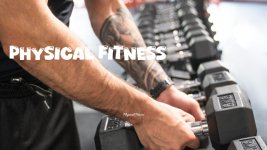junaidhameed
New member
Physical Fitness: A Complete Guide to Health and Wellness

Strength, endurance, flexibility, body composition, and cardiovascular health are all aspects of health-related fitness.
Balance, coordination, agility, power, speed, and response time are all aspects of skill-related fitness.
2. Muscular Strength: The force that a muscle can generate during exercises like push-ups and weightlifting.
3. Muscular Endurance: The capacity of a muscle to execute repeated contractions, such as those found in squats and planks.
4. The range of motion around joints, such as in yoga and stretching, is known as flexibility.
5. Body Composition: The body's proportion of lean muscular mass to fat.
• Strength training: bodyweight exercises, resistance bands, and weightlifting
• Flexibility training: stretching exercises, yoga, and Pilates
• Functional training: workouts that replicate everyday motions, such as kettlebell swings and lunges
• Mix aerobic, strength, and flexibility exercises;
• Start off softly and increase intensity gradually; Consume entire grains, healthy fats, and proteins in a balanced diet.
• To stay hydrated, consume adequate water. Every day, get 7 to 8 hours of good sleep. Use journals or fitness apps to monitor your progress.
Introduction
More than merely exercising, physical fitness is a state of general health and wellbeing that enables your body to perform well in day-to-day activities. It encompasses mental health, stamina, strength, and flexibility. Enhancing your physical fitness can change your life, regardless of your objectives—building muscle, losing weight, increasing energy, or just leading a healthier lifestyle.
What is Physical Fitness?
The ability of the body to carry out daily duties effectively while preserving energy for emergencies and leisure activities is known as physical fitness. Both skill-related fitness and health-related fitness are involved:Strength, endurance, flexibility, body composition, and cardiovascular health are all aspects of health-related fitness.
Balance, coordination, agility, power, speed, and response time are all aspects of skill-related fitness.
Components of Physical Fitness
1. Cardiorespiratory Endurance: The capacity of the heart and lungs to provide oxygen when engaging in physical activity, such as cycling, swimming, or running.2. Muscular Strength: The force that a muscle can generate during exercises like push-ups and weightlifting.
3. Muscular Endurance: The capacity of a muscle to execute repeated contractions, such as those found in squats and planks.
4. The range of motion around joints, such as in yoga and stretching, is known as flexibility.
5. Body Composition: The body's proportion of lean muscular mass to fat.
Benefits of Physical Fitness
Enhances circulation and heart health; increases vitality and stamina; aids in weight management; fortifies bones and muscles; lowers the risk of chronic illnesses (obesity, diabetes, and hypertension); improves mental health by lowering stress, anxiety, and depression; and elevates mood and sleep quality.Best Exercises for Physical Fitness
• Aerobic exercises include cycling, brisk walking, swimming, and running.• Strength training: bodyweight exercises, resistance bands, and weightlifting
• Flexibility training: stretching exercises, yoga, and Pilates
• Functional training: workouts that replicate everyday motions, such as kettlebell swings and lunges
Tips to Improve Physical Fitness
• Be consistent—exercise for at least 30 minutes most days;• Mix aerobic, strength, and flexibility exercises;
• Start off softly and increase intensity gradually; Consume entire grains, healthy fats, and proteins in a balanced diet.
• To stay hydrated, consume adequate water. Every day, get 7 to 8 hours of good sleep. Use journals or fitness apps to monitor your progress.
